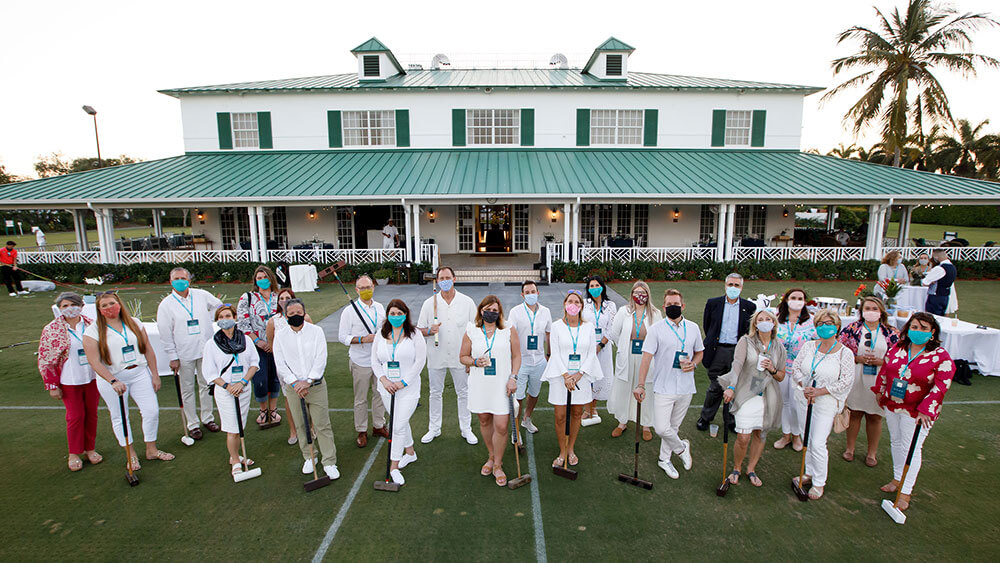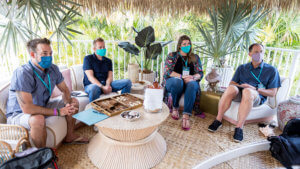
In April, The Palm Beaches and their partners hosted a group of incentive planners to demonstrate how in-person events can provide safe meeting environments without compromising on the participants’ experience. (LILA PHOTO for The Palm Beaches)
Not surprisingly, incentive professionals said last fall that they were struggling to find a balance between safety and quality of experience for their programs, according to The Incentive Travel Industry Index from Financial & Insurance Conference Professionals (FICP), Incentive Research Foundation (IRF), and Society of Incentive Travel Excellence (SITE) Foundation, published in December.
Four months later, The Palm Beaches and their partners hosted a small group of incentive planners to demonstrate how in-person events can deliver on both by providing safe environments to meet without compromising on the participants’ experience.
On the final day of the trip in April, the group of a dozen participants took part in facilitated roundtable discussions to explore considerations for group incentive travel programs moving forward. Here are main takeaways from the conversations, taken from IRF’s white paper, “Buyer Decision Drivers,” available as a complimentary download.
Protocols that instill confidence include the measures they group experienced while in the Palm Beaches: mandatory pre-event testing for all participants, daily health screenings including temperature checks, socially distanced transportation, socially distanced seating, mask wearing indoors, on transportation, and where distancing was not possible outdoors.
One participant felt that the testing mandate was “frustrating” given that many in their group had been vaccinated, adding that “we need to be considering what the next practice should be.”
Communication is critical and needs to be frequent, short, and staggered so that registrants understand what will be required of them and what health and sanitation measures are in place in the host destination. Micro-communications delivered in “drip campaigns” that focused on three to four elements were seen as most effective, according to participants — “a balance of health and safety information, event announcements, and messaging that generates enthusiasm works well.”

Incentive planner participants discuss considerations for group incentive travel programs in the future. (LILA PHOTO for The Palm Beaches)
And in a departure from the approach that incentive event organizers took in pre-COVID times, it’s a good idea to communicate what all elements of the incentive program will entail, rather than adding in any “surprise and delight” activities, so that participants know and are comfortable about what to expect.
Vaccination status info has become a topic of conversation, with employer concerns around privacy and data collection. “Employers need to consult with their attorneys,” IRF’s white paper recommended, “to consider the boundaries around the information they can collect and have a clear plan for how that data will be stored, managed, and shared.” Some employers are using incentives to encourage staff to get vaccinated, and others are considering making vaccination mandatory for participation in incentive award travel — again, after seeking clarity on legal ramifications.
The appetite for travel depends on the industry — those with workforces in public settings, such as construction, tend to be more ready for travel than those who have thrived in remote settings, such as the tech and financial sectors. Some companies, according to one participant, are first offering incentive travel for distributors and dealers, who are a step removed from the company, and prefer to conduct business face to face.
Shorter booking windows are more commonplace. “We’re seeing clients make more go/no-go decisions 60 to 90 days out than ever before,” said one third-party incentive professional in the group. This can be attributed both to companies weighing the risks and benefits and participant readiness to travel.
As travel rebounds, staffing at hotels and airports will continue to be a challenge. “Labor impacts the quality of the experience for the attendee,” said one incentive professional. “Being honest with partners about what has changed in terms of levels of service and compliance to policies on site is more important than ever.”
For more about the group conversations and a list of participants and The Palm Beaches partners, download the complimentary “Buyer Decision Drivers.”
Michelle Russell is editor in chief of Convene.
